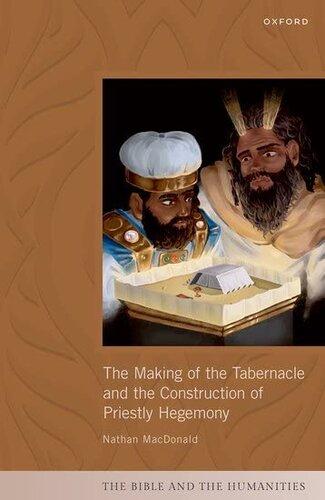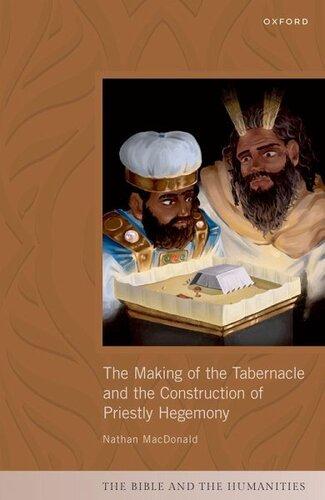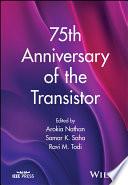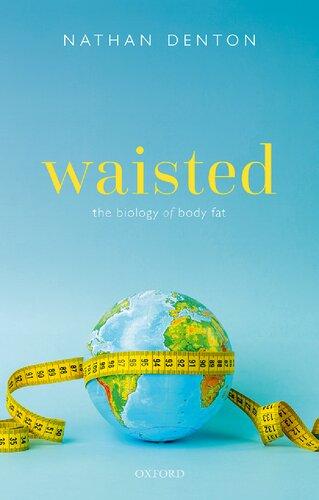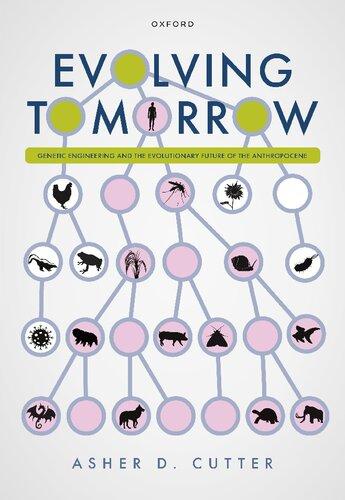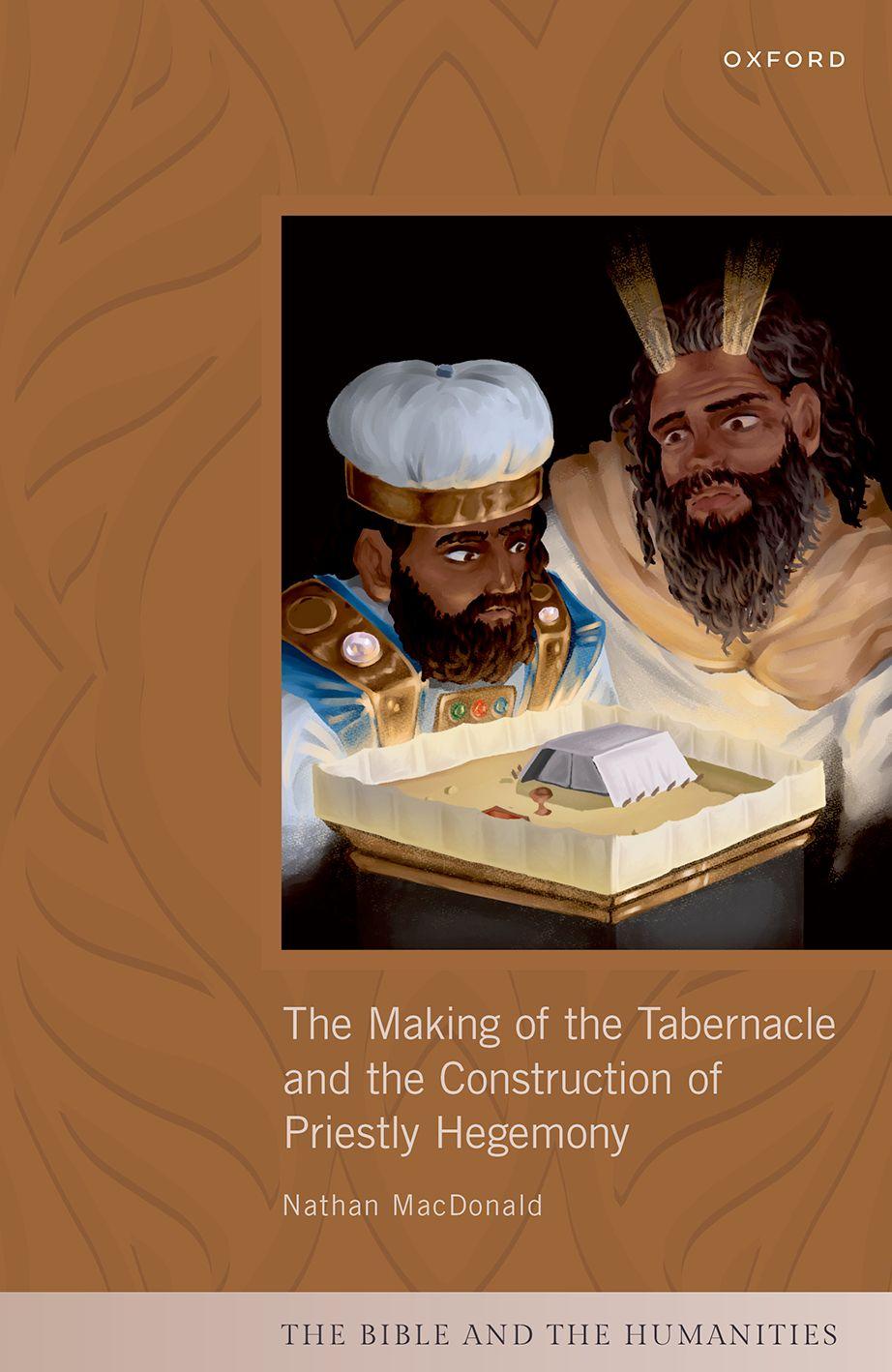The Making of the Tabernacle and the Construction of Priestly Hegemony
NATHAN MACDONALD
Great Clarendon Street, Oxford, OX2 6DP, United Kingdom
Oxford University Press is a department of the University of Oxford. It furthers the University’s objective of excellence in research, scholarship, and education by publishing worldwide. Oxford is a registered trade mark of Oxford University Press in the UK and in certain other countries
© Nathan MacDonald 2023
The moral rights of the author have been asserted
All rights reserved. No part of this publication may be reproduced, stored in a retrieval system, or transmitted, in any form or by any means, without the prior permission in writing of Oxford University Press, or as expressly permitted by law, by licence or under terms agreed with the appropriate reprographics rights organization. Enquiries concerning reproduction outside the scope of the above should be sent to the Rights Department, Oxford University Press, at the address above
You must not circulate this work in any other form and you must impose this same condition on any acquirer
Published in the United States of America by Oxford University Press 198 Madison Avenue, New York, NY 10016, United States of America
British Library Cataloguing in Publication Data Data available
Library of Congress Control Number: 2023935844
ISBN 978–0–19–881385–9
DOI: 10.1093/oso/9780198813859.001.0001
Printed and bound in the UK by Clays Ltd, Elcograf S.p.A.
Links to third party websites are provided by Oxford in good faith and for information only. Oxford disclaims any responsibility for the materials contained in any third party website referenced in this work.
To Callum
(Prov 23.24)
Preface
This book originates in the summer of 2020 though parts of it had been written earlier. For the most part that summer was taken up with other concerns. At home with three children, I juggled adjusting undergraduate courses to work online with childcare and schooling. In the few spare moments I had to think about research, I re-read and tinkered with a lengthy paper that I had written a couple of years earlier on the sin of Nadab and Abihu. Unsure of what to do with something that had grown beyond the confines of a journal article, I sent copies to a few friends and colleagues asking for thoughts. Gary Anderson kindly read the paper and offered to chat about it over the phone. Gary’s insights into the relationship between Exod 40 and Lev 9 helped make sense of a number of issues and at the end of the conversation I could see how various things I had been working on previously all belonged together. This book would not have existed without that conversation and I am grateful to Gary for his time and insights. His book on the tabernacle should appear a little before this one. It appears that books on the tabernacle are like London buses: you wait an age for one to appear, and then two come at once. My own book takes a different approach to Gary’s, which I have had the privilege of reading pre-publication. The story is told that the puritan Thomas Manton almost gave up writing his commentary on Jude when he learned that William Jenkyn had published his own. He was eventually prevailed upon to continue with his labours, writing in the introduction, ‘I consulted with my reverend brother’s book, and when I found at any point at large discussed by him, I either omitted it or mentioned it very briefly; so that his labours will be necessary to supply the weakness of mine.’ A remarkable claim given the length of both commentaries on such a modest biblical text. Nevertheless, Manton’s observation may well assist the readers of this present volume who should also ensure they avail themselves of the wisdom to be found in That I May Dwell among Them: The Biblical Concept of Incarnation and Atonement (Eerdmans, forthcoming).
I owe a second debt to Hindy Najman who has been a good friend and generous encourager of my work ever since she arrived in Oxford to take up the Oriel and Laing Professorship of the Interpretation of Holy Scripture. I have benefited from several conversations with her about the book and she has been a regular source of insights and ideas. The breadth of her hermeneutical vision has challenged me on a variety of issues, and she has pushed me to think along unfamiliar lines in ways that have greatly profited this project. Her initiatives at the
boundaries of scholarship have been a constant source of inspiration, and I count it a huge privilege to have this book published in her series on the Bible and the Humanities.
A third debt is owed to Angela Erisman. For the past six years, I have had the pleasure of working together with Angie as co-chairs of the Pentateuch section at the annual meeting of the SBL. Those six years have been a true gift and the friendship with Angie has been one of the most rewarding of my academic career. Regular emails and zoom meetings during the pandemic and afterwards have encouraged me to think more carefully about what I am doing and to reflect more deeply on critical issues. Writing a book is sometimes a rather lonely business, but with Angie also completing her own book at the same time, I have felt like a runner with a companion. As a result, the entire race has been far more enjoyable.
Gary, Hindy, and Angela merit particular mention, but there are many others who have contributed to this book in ways large and small. I am grateful to Anselm Hagedorn and Noam Mizrahi for sourcing materials that were difficult to obtain during the pandemic. Also to Yitzhaq Feder, Christian Frevel, Benedikt Jürgens, Edgar Kellenberger, John B. Miller, and Christophe Nihan, for making available their essays that were otherwise inaccessible. Several colleagues were kind enough to provide me with pre-publication materials: Gary Anderson, Graham Davies, Hila Dayfani, Nancy Erickson, Christian Frevel, Jurg Hützli, Drew Longacre, Alice Mandell, Julia Rhyder, Larry Schiffman, and Sarah Schulz. I am also deeply indebted to Stefan Schorch who made available the latest version of his critical edition of the Samaritan Pentateuch for both Exodus and Numbers. Jesse Grenz, Caio Peres, and Paul Aaron Thomas kindly shared their unpublished theses or dissertations with me.
Much of this book was written during the Covid pandemic and its aftermath. Special thanks are due to the librarians at the University Library in Cambridge who provided materials through their Scan and Deliver service. Some of this book would not have been possible without the digitization of manuscripts by the Vatican Library in Rome, the Chester Beatty Library in Dublin, and the Bayerische Staatsbibliothek in Munich.
Over the last few years, various colleagues have read drafts of chapters, responded to papers presented at conferences or discussed matters in which they were specialists: James Aitken, Annie Calderbank, Graham Davies, Hila Dayfani, Marieke Dhont, Liane Feldman, Ron Hendel, Philip Jenson, Reinhard Kratz, Paul Kurtz, Mark Leuchter, Christoph Levin, Alice Mandell, Reinhard Müller, Christophe Nihan, Saul Olyan, Julia Rhyder, Harald Samuel, and James Watts. I also benefited from the questions and discussions following presentations at the Society for Old Testament Study (SOTS), the Society of Biblical Literature (SBL), Georg-August–Universität Göttingen, King’s College London, Oxford University, and Edinburgh University.
Some of the arguments in this book have appeared in earlier forms. In most cases, they have been significantly revised in the process of writing this book. An early version of parts of Chapter 5 appeared as ‘The Priestly Vestments’, in Christoph Berner, Manuel Schäfer, Martin Schott, Sarah Schulz, and Martina Weingärtner (Eds), Nudity and Clothing in the Hebrew Bible (T&T Clark, 2019), 435–48. Parts of the argument of Chapter 8 were published in ‘Error and Response in Leviticus 10’, Ancient Jew Review (<https://www.ancientjewreview.com/ read/2022/2/2/error-and-response-in-leviticus-10>; published 8 February 2022) and ‘Whose Hattāʾt? Aaron’s Enigmatic Response to Moses in Lev 10:19’, ZAW 133 (2021): 23–36. Finally, some of Chapter 9 was published at ‘The Offerings of the Tribal Leaders, the Purification of the Levites, and the Hermeneutics of Ritual Innovation’, in Laura Quick and Melissa Ramos (Eds), New Perspectives on Ritual in the Biblical World (LHBOTS 702; T&T Clark, 2022), pp. 199–211. An early version of some of my arguments in Chapter 10 appeared as part of ‘Scribalism and Ritual Innovation’, HeBAI 7 (2018), pp. 415–29 <https://doi.org/10.1628/ hebai-2018-0027>. I am grateful to Ancient Jew Review, de Gruyter, Mohr Siebeck Tübingen, and T&T Clark, an imprint of Bloomsbury International Plc, for permission to republish this earlier material.
I am grateful to my colleagues in the Divinity Faculty in Cambridge for permitting me to take leave during which the bulk of this book was completed. I owe a particular debt to Katharine Dell and my late - and much lamented - colleague James Aitken who covered various responsibilities in the teaching of Hebrew Bible while I was away, and also to other Cambridge colleagues including Olga Fabrikant-Burke, Alison Gray, Philip Jenson, Sophia Johnson, and Hilary Marlow. The Master and Fellows of St John’s College relieved me of my college duties for the same period. I am thankful not only for that relief, but also for the extraordinary privilege to be part of such a wonderful academic community. I am particularly grateful to Simeon Zahl for looking after the theologians in St John’s during my leave. That sabbatical was mostly spent in Cambridge, but I was also fortunate to spend two months in Munich as a fellow at the Münchner Zentrum für Globalgeschichte. Much of the time there was spent on a future project, but it did also enable me to check references and work on some aspects of the book. I am grateful to Susanne Hohler, Philipp Stockhammer, and Roland Wenzlhuemer for their hospitality. I would also like to thank Jacob Deans for the indexing and Callum for providing the cover design.
In his commentary, William Propp notes that ‘the time we spend in reconstructing the Tabernacle is sacred time; the image held in our minds is sacred space’. Much of that sacred time and sacred space has been gifted to me by my family. They have been wonderfully understanding of my obsessions and gently teased the ‘Tabernacle Man’. With Claire, Callum, Eilidh, and Morven, I could not be happier and more fortunate. It is a real pleasure to dedicate this book to Callum, our eldest. No parents could be prouder of the young man their son has become.
List of Abbreviations
* an earlier layer found within the biblical text indicated
[ ] lacuna
[text] reconstructed text
<text> marginal correction
ׁא probable letter
ׁא possible letter
⅏ Samaritan Pentateuch
⅏D Samaritan Pentateuch (MS. Dublin Chester Beatty Library 751)
�� Old Greek
��A Old Greek—Codex Alexandrinus (Royal MS 1 D.v–viii, British Library, London)
��B Old Greek—Codex Vaticanus (Vat.gr.1209, Vatican Library, Rome)
�� Old Latin
��L Old Latin—Codex Lugdunensis (403 [329], Bibliothèque municipale, Lyon)
��M Old Latin—Codex Monacensis (Clm 6225, Bayerische Staatsbibliothek, Munich)
�� Masoretic Text
��L Masoretic Text—Codex Leningrad (Firkovitch I, B19a, National Library of Russia, Leningrad)
AABNER AABNER: Advances in Ancient, Biblical, and Near Eastern Research
AAWG Abhandlungen der Akademie der Wissenschaften in Göttingen
AB Anchor Bible
ABG Arbeiten zur Bibel und ihrer Geschichte
ADPV Abhandlungen des Deutschen Palästina-Vereins
AGJU Arbeiten zur Geschichte des antiken Judentums und des Urchristentums
AGLB Aus der Geschichte der lateinischen Bibeltexte (= Vetus Latina: die Reste der altlateinischen Bibel)
AIL Ancient Israel and its Literature
ANEM Ancient Near Eastern Monographs
ASOR American Schools of Oriental Research
ATD Das Alte Testament Deutsch
ATSAT Arbeiten zu Text und Sprache im Alten Testament
BBB Bonner biblische Beiträge
BEATAJ Beiträge zur Erforschung des Alten Testaments und des antiken Judentums
BETL Bibliotheca Ephemeridum Theologicarum Lovaniensium
BHQ Biblia Hebraica Quinta
Bib Biblica
BibInt Biblical Interpretation
xiv List of Abbreviations
BJRL Bulletin of the John Rylands Library
BJS Biblical and Judaic Studies
BKAT Biblischer Kommentar, Altes Testament
BN Biblische Notizen
BRLJ Brill Reference Library of Judaism
BWANT Beiträge zur Wissenschaft vom Alten und Neuen Testament
BZ Biblische Zeitschrift
BZABR Beihefte zur Zeitschrift für altorientalische und biblische Rechtsgeschichte
BZAW Beihefte zur Zeitschrift für die alttestamentliche Wissenschaft
BZNW Beihefte zur Zeitschrift für die neutestamentliche Wissenschaft
CBC Cambridge Bible Commentary
CBET Contributions to Biblical Exegesis and Theology
CBQ Catholic Biblical Quarterly
CC Continental Commentaries
CHANE Culture and History of the Ancient Near East
DJD Discoveries in the Judaean Desert
DSD Dead Sea Discoveries
ErIsr Eretz Israel
ETR Études théologiques et religieuses
FAT Forschungen zum Alten Testament
FOTL Forms of the Old Testament Literature
FRLANT Forschungen zur Religion und Literatur des Alten und Neuen Testaments
GKC Emil Kautzsch (ed.), Gesenius’ Hebrew Grammar, trans. Arthur E. Cowley, 2nd edn, Oxford: Clarendon, 1910
HALOT Ludwig Koehler, Walter Baumgartner, and Johann J. Stamm, The Hebrew and Aramaic Lexicon of the Old Testament, trans. and edited under the supervision of Mervyn J. Richardson, 4 vols, Leiden: Brill, 1994–99
HAR Hebrew Annual Review
HAT Handbuch zum Alten Testament
HBM Hebrew Bible Monographs
HBS Herders Biblische Studien
HCOT Historical Commentary on the Old Testament
HDB James Hastings (ed.), A Dictionary of the Bible, 5 vols, New York: Charles Scribner’s Sons, 1898–1904
HeBAI Hebrew Bible and Ancient Israel
HKAT Handkommentar zum Alten Testament
HSS Harvard Semitic Studies
HTKAT Herders Theologischer Kommentar zum Alten Testament
HTR Harvard Theological Review
IBC Interpretation: A Bible Commentary for Teaching and Preaching
ICC International Critical Commentary
IEJ Israel Exploration Journal
JAJSup Journal of Ancient Judaism, Supplement Series
JANER Journal of Ancient Near Eastern Religions
JAOS Journal of the American Oriental Society
JBL Journal of Biblical Literature
JHebS Journal of the Hebrew Scriptures
JNES Journal of Near Eastern Studies
JNSL Journal of Northwest Semitic Languages
JQR Jewish Quarterly Review
JSCS Journal of Septuagint and Cognate Studies
JSJ Journal for the Study of Judaism
JSJSup Supplements to the Journal for the Study of Judaism
JSOT Journal for the Study of the Old Testament
JSOTSup Journal for the Study of the Old Testament, Supplement Series
JSS Journal of Semitic Studies
JTS Journal of Theological Studies
KeHAT Kurzgefasstes exegetisches Handbuch zum Alten Testament
KHAT Kurzer Hand-Commentar zum Alten Testament
LASBF Liber Annuus Studii Biblici Franciscani
LHBOTS Library of Hebrew Bible/Old Testament Studies
LSTS Library of Second Temple Studies
MdB Le Monde de la Bible
NCB New Century Bible
NICOT New International Commentary on the Old Testament NovTSup Supplements to Novum Testamentum
nrsv New Revised Standard Version
OBO Orbis Biblicus et Orientalis
Or Orientalia
OTL Old Testament Library
Pg Priestly Grundschrift
PEQ Palestine Exploration Quarterly
Post Postscripts: The Journal of Sacred Texts, Cultural Histories, and Contemporary Contexts
Proof Prooftexts: A Journal of Jewish Literary History
RB Revue Biblique
RBS Resources for Biblical Study
RevQ Revue de Qumran
RlA Erich Ebeling et al. (eds.), Reallexicon der Assyrologie. Berlin: de Gruyter, 1928–
SBLMS Society of Biblical Literature Monograph Series
SBT Studies in Biblical Theology
ScrHier Scripta Hierosolymitana
SCS Septuagint and Cognate Studies
SemeiaSt Semeia Studies
SJ Studia Judaica
SJLA Studies in Judaism in Late Antiquity
STDJ Studies on the Texts of the Desert of Judah
Targ. Neo. Targum Neofiti
Targ. Onq. Targum Onqelos
ThR Theologische Rundschau
xvi List of Abbreviations
TOTC Tyndale Old Testament Commentaries
TSAJ Texts and Studies in Ancient Judaism
TSK Theologische Studien und Kritiken
UCPNES University of California Publications, Near Eastern Studies
UTB Uni-Taschenbücher
VT Vetus Testamentum
VTSup Supplements to Vetus Testamentum
WBC Word Biblical Commentary
WC Westminster Commentaries
WMANT Wissenschaftliche Monographien zum Alten und Neuen Testament
WUNT Wissenschaftliche Untersuchungen zum Neuen Testament
ZABR Zeitschrift für altorientalische und biblische Rechtsgeschichte
ZBK Zürcher Bibelkommentar
ZDPV Zeitschrift des Deutschen Palästina-Vereins
Introduction
In the summer of 586 bce and after a prolonged siege, Jerusalem was conquered by the army of the Babylonian king, Nebuchadnezzar. With the city’s fall, the small kingdom of Judah and its native dynasty came to an end. The last king, Zedekiah, sought to flee the city, but was captured by Babylonian forces in the environs of Jericho. He was sent to appear before Nebuchadnezzar at his headquarters in Riblah on the Orontes where he was judged and deported to Babylon to live out his remaining days in humiliating servitude.1 Back in the city, the chief priest and his deputy, together with the temple guardians, seem to have remained at their posts. There they were captured before they too were sent to Riblah where they were flogged and executed together with other city officials. The contrasting fates of Zedekiah and his officers highlight their different status in the eyes of their captors. It was to be another four centuries before local rule was restored to this corner of the Levant when the Hasmoneans exploited divisions within the Seleucid empire to secure a measure of independence. The Hasmoneans took various titles, including governor, ethnarch, ruler, and eventually even king,2 but their claim to hegemony stemmed from their holding the office of high priest. How did the high priesthood go from being an important, but subordinate, office in the kingdom of Judah to being the principal source of authority?
It was long believed that a significant shift in the power wielded by the high priest had occurred during the early years of the Achaemenid empire. The prophetic books of Haggai and Zechariah appear to suggest that the returning Jewish community was jointly led by Zerubbabel, a scion of the former royal dynasty, and Joshua, a descendant of the last chief priest Seraiah. This dyarchy of governor and priest did not endure and Zerubbabel’s absence from some of Zechariah’s oracles was often thought to reflect Persian fears that some of Zerubbabel’s supporters harboured ambitions to restore the Davidic dynasty. In this view, oracles were hastily rewritten to remove references to the royal pretender with the result
1 Zedekiah’s end is described in Jer 52.11, but not in the parallel text of 2 Kgs 25.7. The precise implications of his imprisonment in תֹדֻּקְפַּה־תיֵב, ‘house of punishment’, is disputed, not least because of the Greek reading, οἰκίαν μυλῶνος, ‘house of milling’. For discussion, see William McKane, A Critical and Exegetical Commentary on Jeremiah. Volume II: Commentary on Jeremiah XXVI–LII, ICC (Edinburgh: T&T Clark, 1996), 1365. For the fates of Zedekiah and his officials in Jeremiah, see Henk de Waard, Jeremiah 52 in the Context of the Book of Jeremiah, VTSup 183 (Leiden: Brill, 2020), 109–42.
2 Josephus and Strabo disagree about which of the Hasmoneans was the first to take the title ‘king’ (βασιλεύς). According to Josephus it was Aristobulus I who first ‘assumed the diadem’ (J.W. 1.3.1), but Strabo credits Alexander Jannaeus with this distinction (Geogr. 16.2.40).
Making of the Tabernacle and the Construction of Priestly Hegemony. Nathan MacDonald, Oxford University Press.
Nathan MacDonald 2023. DOI: 10.1093/oso/9780198813859.003.0001
that the high priest alone bore a crown and sat upon a throne. The following decades saw the high priests consolidate their power as any lingering hopes that the Davidic dynasty would be revived faded.3 For much recent scholarship, the historical reconstruction of the high priest’s supremacy during the Persian period is belied by epigraphic and numismatic evidence which shows that the province of Yehud was ruled for most, if not all, of the period by Persian-appointed governors.4
Determining how the priesthood developed in the late Persian and early Hellenistic periods has been afflicted by several difficulties. Scholarship has struggled to describe well the influence wielded by the high priest during this period. Deborah Rooke, for example, makes a sharp distinction between civil and cultic leadership. In the ancient world, however, the two spheres intersected in complex ways.5 Similar difficulties arise with Lisbeth Fried’s claim that the high priests ‘held little real power’.6 Fried appears to have in mind what some would describe as coercive power, and it is true that such power was only wielded by the governor. Nevertheless, her language is intriguing, if also problematic, for it suggests there are other types of power, even if these are somehow less ‘real’. Despite her headline claim, Fried recognizes that local aristocracies and priesthoods resisted encroachment on their traditional competencies, and enjoyed some influence as members of the local bureaucracy.7 The decision of the leaders of the Elephantine community to write to the high priest and aristocrats in Jerusalem, for example, suggests that they believed the Judean community leaders could exercise some influence. In other words, they had some sort of power.
A further difficulty that afflicts any historical reconstruction of the priesthood’s development is the paucity of evidence. This is true of the entire period from the ascendancy of the Persians to the Maccabean revolt, but is especially the case for
3 Rooke cites some of the earlier scholarship holding this position (Deborah W. Rooke, Zadok’s Heirs: The Role and Development of the High Priesthood in Ancient Israel [Oxford: Oxford University Press, 2000], 1–4). Grabbe maintains that there was a dyarchy in Yehud already in the late sixth century and perhaps in the following centuries (Lester L. Grabbe, A History of the Jews and Judaism in the Second Temple Period. Vol 1: Yehud: A History of the Persian Period of Judah, LSTS 47 [London: T&T Clark, 2004], 147–8; Lester L. Grabbe, ‘The Priesthood in the Persian Period: Haggai, Zechariah, and Malachi’, in Priests and Cults in the Book of the Twelve, ed. Lena-Sofia Tiemeyer, ANEM 14 [Atlanta: Society of Biblical Literature, 2016], 149–56). Wöhrle also argues that the earliest prophetic oracles in Haggai and Zechariah propound the idea of a dyarchy, but this was later edited to support a hierocracy (Jakob Wöhrle, ‘On the Way to Hierocracy: Secular and Priestly Rule in the Books of Haggai and Zechariah’, in Priests and Cults in the Book of the Twelve, ed. Lena-Sofia Tiemeyer, ANEM 14 [Atlanta: Society of Biblical Literature, 2016], 173–90).
4 A table which synchronizes as far as possible the satraps of Eber-nari, the governors of Yehud and Samaria, and the high priests in Jerusalem can be found in Reinhard Achenbach, ‘Satrapie, Medinah und lokale Hierokratie: Zum Einfluss der Statthalter der Achämenidenzeit auf Tempelwirtschaft und Tempelordnungen’, ZABR 16 (2010): 111.
5 Rooke, Zadok’s Heirs.
6 Lisbeth S. Fried, The Priest and the Great King: Temple-Palace Relations in the Persian Empire, BJS 10 (Winona Lake, IN: Eisenbrauns, 2004), 233.
7 E.g. Fried, Priest, 202, 212.
the late Persian and early Hellenistic periods. The consequences of this data poverty are apparent in the failure of any consensus to emerge within contemporary scholarship about how and when the high priest rose to supremacy. Did he accrue power alongside the governor so that a dyarchy emerged before giving way to a hierocracy?8 Or was the seizure of power by the high priest sudden and driven by a specific set of events, such as the transfer of Yehud to Greek hegemony as a result of Alexander the Great’s conquests9 or the interventions of the Seleucid king Antiochus IV into the affairs of the Jerusalem temple?10
A final difficulty that may be observed is the significant interpretive challenge of interpreting the texts of the Hebrew Bible, our most significant and extensive collection of sources for the priesthood in Persian-period Judaism. Stated simply, our texts do not often seem to reflect the social realities of the period which they purport to describe. It is not just that we must reckon with a complex redactional history, but it is also the fact that the portrayal may reflect the ambitions of a scribal minority.11 The biblical texts may provide some of the conditions for the priesthood’s supremacy emerging in subsequent centuries, but they may not reflect the reality of their own situation. In other words, as Frevel argues for the portrayal of the priesthood in the book of Numbers, it is often the case that it was not ‘the political development [that] shaped the text, but rather the other way around’.12 Thus, the reconstruction of the priesthood’s history is entangled in the question of how the ideological justification for the priesthood’s supremacy developed. As a result, our sources for the history of the priesthood need to be utilized with considerable care, and, crucially, careful comparison made with the full range of available evidence.
In recent scholarship, various significant texts have benefited from incisive critical analysis, including Haggai and Zech 1–8,13 Ezra-Nehemiah,14 and
8 Schaper, for example, argues that a dyarchy emerged in the mid-fourth century (Joachim Schaper, Priester und Leviten im achämenidischen Juda: Studien zur Kult- und Sozialgeschichte Israels in persischer Zeit, FAT 31 [Tübingen: Mohr Siebeck, 2000]). For the argument that the high priest progressively accrued power during the fourth century bce see Wolfgang Oswald, ‘Der Hohepriester als Ethnarch. Zur politische Organisation Judäas im 4. Jahrhundert v. Chr’, ZABR 21 (2015): 309–20.
9 See, e.g., James C. VanderKam, From Joshua to Caiaphas: High Priests after the Exile (Minneapolis: Fortress, 2004); Jeremiah W. Cataldo, A Theocratic Yehud? Issues of Governance in a Persian Province, LHBOTS 498 (London: Bloomsbury T&T Clark, 2009).
10 See, e.g., Rooke, Zadok’s Heirs; Sarah Schulz, Joschua und Melchisedek: Studien zur Entwicklung des Jerusalemer Hohepriesteramtes vom 6. Jahrhundert v. Chr. bis zum 2. Jahrhundert v. Chr., BZAW (Berlin: de Gruyter, forthcoming).
11 For detailed discussion of the possible redactional development and its significance for the history of the priesthood, see Schulz, Joschua
12 Christian Frevel, ‘Leadership and Conflict: Modelling the Charisma of Numbers’, in Debating Authority: Concepts of Leadership in the Pentateuch and Former Prophets, eds. Katharina Pyschny and Sarah Schulz, BZAW 507 (Berlin: de Gruyter, 2018), 106.
13 Rooke, Zadok’s Heirs, 125–51; VanderKam, From Joshua, 1–42; Schulz, Joschua
14 Rooke, Zadok’s Heirs, 152–74; Fried, Priest; Donna Laird, Negotiating Power in Ezra-Nehemiah, AIL 26 (Atlanta: SBL Press, 2016).
Numbers.15 Arguably, however, one of the most important texts is frequently overlooked: the tabernacle and ordination accounts of Exod 25–31, 35–40 and Lev 8–10. The reasons for their omission are not difficult to discern. These chapters are not a historiographic text in the way that Haggai, Zech 1–8 or EzraNehemiah are. In addition, they also belong to a documentary source that is often thought to have originated before the Second Temple was established. This is true not only of the Jerusalem school that would locate the origins of the priestly literature in the monarchic period, but also for some proponents of continental criticism who would date it in the late neo-Babylonian or early Persian period. For both of these perspectives, the priestly literature forms the background for later Persian period texts.16 In this study, however, I seek to demonstrate that the tabernacle and ordination accounts developed during the Persian period, and that they make an important contribution to our understanding of how ideological justification for the high priesthood’s supremacy developed.
The Tabernacle and Social Structure
It has not always been obvious that the tabernacle account in Exodus might contribute to our understanding of priestly hegemony in early Judaism. In the middle part of the twentieth century, biblical scholarship mostly focused on how these chapters reflect Israelite ideas about divine presence and how these related to the historicity of traditions about tent shrines. The keen interest in divine presence was part of a larger focus upon the contribution that the Old Testament might make to Christian theological reflection that came about in the wake of Karl Barth.17 It was observed that the end of the book of Exodus uses two different names for the sanctuary that God commands Moses to construct. The first title is the Hebrew term ןָכְּשִׁמ which has conventionally been translated into English as ‘tabernacle’. The English gloss is a transliteration of the Latin tabernaculum, which was used to render the Greek term σκηνή, ‘tent’. Whilst the Greek and Latin terms draw attention to the shrine’s structural form, the Hebrew word ןָכְּשִׁמ is a noun formed from the verb ן׳׳כשׁ, ‘to dwell’, and a more suitable translation might be ‘dwelling’. The second name given to the sanctuary is דֵעוֹמ לֶהֹא, ‘tent of meeting’. The alternative designations for the tent suggest two rather different conceptions of the divine presence. In the first God resides in the sanctuary, but in the second God encounters the people, perhaps only intermittently. Examining these two
15 Reinhard Achenbach, Die Vollendung der Tora: Studien zur Redaktionsgeschichte des Numeribuches im Kontext von Hexateuch und Pentateuch, BZABR 3 (Wiesbaden: Harrassowitz, 2003); Katharina Pyschny, Verhandelte Führung: Eine Analyse von Num 16–17 im Kontext der neueren Pentateuchforschung, HBS 88 (Freiburg im Breisgau: Herder, 2017); Frevel, ‘Leadership and Conflict’.
16 Rooke, Zadok’s Heirs.
17 An influential example is von Rad: Gerhard von Rad, Old Testament Theology, 2 vols. (New York: Harper & Row, 1962), I: 234–41.
notions of divine presence and the relationship between them has occupied considerable scholarly attention which continues into the present.18 The assessment of the different theologies of divine presence was often closely bound to claims about the antiquity of Israel’s historical traditions of a tent shrine. Despite Wellhausen’s famous assertion in the nineteenth century that ‘the tabernacle is the copy, not the prototype, of the temple in Jerusalem’,19 various ancient parallels from Ugarit, Mari, Midian, and Egypt, were adduced to support the possibility that cultic worship in a tent was an early tradition. The quest for Near Eastern analogies has also continued in recent scholarship.20
The way in which the presentation of the tabernacle portrays a hierocratic society first emerges with clarity in the seminal work by Menahem Haran on temples and temple service. Haran demonstrated how increased technical workmanship and material value indicated greater sanctity. The instructions for the tabernacle envisaged a concentric structure with the small room where the ark was to be placed as the focal point and the place of greatest holiness. Moving outwards from the holy of holies resulted in diminished sanctity and material decoration. The concentric circles of holiness also determine access with only the high priest able to enter all parts of the tabernacle complex including the holy of holies. Priests, Levites, and ordinary Israelites—in that order—enjoy diminishing access and sight of the tabernacle and its furniture.21
The potential of thinking about the tabernacle as a space that maps Israel’s social configuration was developed in a suggestive monograph by Mark George. Utilizing Henri Lefebvre’s theory of space he examines how the tabernacle narratives are a cultural production expressing the priestly understanding of Israel’s social organization. George worked with the Masoretic Text of Exod 25–40 which he regards as an exilic composition. The exilic context looms large in George’s analysis for he argues that the tabernacle account has reappropriated royal
18 See, e.g., Benjamin Sommer, ‘Conflicting Constructions of Divine Presence in the Priestly Tabernacle’, BibInt 9 (2001): 41–63. For a discussion of the issue and an account of the scholarly literature, see most recently Domenico Lo Sardo, Post-Priestly Additions and Rewritings in Exodus 35–40, FAT II/119 (Tübingen: Mohr Siebeck, 2020), 121–230.
19 Julius Wellhausen, Prolegomena to the History of Israel with a Reprint of the Article Israel from the ‘Encyclopaedia Britannica’, trans. John Sutherland Black and Allan Menzies (Edinburgh: Black, 1885), 37.
20 See, inter alia, Frank Moore Cross, ‘The Tabernacle: A Study from an Archaeological and Historical Approach’, BA 10 (1947): 45–68; Richard J. Clifford, ‘Tent of El and the Israelite Tent of Meeting’, CBQ 33 (1971): 221–7; Frank Moore Cross, ‘The Priestly Tabernacle in the Light of Recent Research’, in The Temple in Antiquity: Ancient Records and Modern Perspectives, ed. Truman G. Madsen (Provo, UT: Brigham Young University Press, 1984), 91–105; Daniel E. Fleming, ‘Mari’s Large Public Tent and the Priestly Tent Sanctuary’, VT 50 (2000): 484–98; Michael M. Homan, To Your Tents, O Israel!: The Terminology, Function, Form, and Symbolism of Tents in the Hebrew Bible and the Ancient Near East, CHANE 12 (Leiden: Brill, 2002); Madadh Richey, ‘The Dwelling of ˀIlu in Baˁlu and ˀAqhatu’, JANER 17 (2017): 149–85.
21 Menahem Haran, Temples and Temple-Service in Ancient Israel (Oxford: Clarendon Press, 1978), 149–88. See also Jenson whose analysis of the spatial dimension of the tabernacle account is followed by the personal dimension because of their close correlation (Philip Peter Jenson, Graded Holiness: A Key to the Priestly Conception of the World, JSOTSup 106 [Sheffield: JSOT Press, 1992], 89–148).
building inscriptions and foundation deposits and attributed the monarch’s role to the people. ‘The Priestly writers thus democratize the king’s role in royal building projects, spreading it out among the people.’22 The notion of the tabernacle texts as democratizing sits somewhat uncomfortably alongside George’s recognition that entering holier space is restricted by narrowing social criteria of descent, gender, and hereditary succession. He shows no interest in exploring this tension despite his use of the analytical framework of a Marxist theorist.
The tension between hierocratic and democratic explanations is not unique to George. It also emerges in the different analyses of the opening chapters of Leviticus by James Watts and Liane Feldman. Their divergent accounts of how power operates in the priestly literature is especially striking because they examine the same text (Leviticus) with similar methodological interests (narratological and rhetorical). Watts argues that Lev 1–16 justifies control of the cult and its perquisites by the priests. Even the story of Nadab and Abihu’s infraction in Lev 10, does not serve to undermine the claims of the Aaronides, but highlights the dangers inherent in their role. They deserve the rewards that accrue to the priests because of the extraordinary risks they take.23 Feldman, on the other hand, argues that Leviticus rests authority with the Israelites by lifting the veil on cultic affairs. It is not the priests who are addressed in Lev 1–16, but the Israelites (Lev 1.1; 4.1; 11.1; 12.1; 15.1). ‘The narrator’s choice to allow the reader-Israelite to hear and see the internal workings of the cult challenges the hegemony of the priesthood and centers the ordinary Israelite in the life of the cult. In many ways, this is a story of the democratization of ideas about religious practice in ancient Israel.’24 Since Watts and Feldman can appeal to features of the text of Leviticus as well as the broader historical context to justify their understandings of the priestly literature, we return to the problem already seen with Rooke and Fried that biblical scholarship needs a more sophisticated and nuanced account of power. Only in this way will we reach a deeper and integrated understanding of the apparent hierocratic and democratic features of priestly texts.
A Theory of Power
Amongst the various theorists of power, Michel Foucault is especially useful for this study because he worked within the field of history, rather than viewing the subject through a primarily philosophical lens. Whatever is made of his specific
22 Mark K. George, Israel’s Tabernacle as Social Space, AIL 2 (Atlanta, GA: Society of Biblical Literature, 2009), 166.
23 James W. Watts, Ritual and Rhetoric in Leviticus: From Sacrifice to Scripture (Cambridge: Cambridge University Press, 2007); cf. James W. Watts, ‘Aaron and the Golden Calf in the Rhetoric of the Pentateuch’, JBL 130 (2011): 417–30.
24 Liane Marquis Feldman, The Story of Sacrifice: Ritual and Narrative in the Priestly Source, FAT 141 (Tübingen: Mohr Siebeck, 2020), 198.
historical arguments, he shows an attentiveness to historical particularities and the embedding of power within concrete social practices and institutions. Whilst Foucault’s thinking developed over time and was never presented systematically, his writings are characterized by a distinctive set of perspectives and concerns that emerge in different forms.25 Thus, whilst the focus on power only emerges after he published The Archaeology of Knowledge in 1969, earlier works can be seen to have power as their concern even if not named explicitly, as Foucault himself recognized.26
Much of Foucault’s work was concerned with social institutions—the asylum, the clinic, the prison—and their utilization of scientific discourse.27 Foucault argued that in the eighteenth and nineteenth centuries these institutions reflected new configurations of power and knowledge—a shift from one episteme to another. The epistemes are characterized by discursive formations that define what is intelligent and appropriate. They also set parameters for what was true, and they did so in a manner that made the previous discursive formations appear irrational or unjust. Foucault frequently began his studies juxtaposing striking examples that epitomize two epistemes. The Birth of the Clinic contrasts the description of how a hysteric was cured in the eighteenth century with that of a patient suffering from chronic meningitis a century later. In Discipline and Punish, Foucault follows an exacting account of the execution of a regicide with the disciplinary regime of a prison eighty years later. These examples illustrate how dramatically the discursive formations had changed, but also highlight continuities and discontinuities. Vaporous disorders are replaced by a scientific anatomy, whilst extreme physical torture gives way to incarceration. Yet, the earlier physician is no less attentive to description of the body’s pathologies just as the executioner is no less precise in meting out punishment.28 Foucault’s earlier studies mapped out the differences between epistemes and how these were reflected in numerous fields, but with Discipline and Punish he also sought to explain the transformations that took place.29
Foucault’s contributions to the understanding of power can be seen as an attempt to displace occasional displays of violent sovereignty as the main way to view the exercise of power. In modern societies, power most often takes place
25 As Haugaard observes, Foucault’s work forms ‘a unity with differences of emphasis rather than of fundamental substance’ (Mark Haugaard, The Constitution of Power: A Theoretical Analysis of Power, Knowledge and Structure [Manchester: Manchester University Press, 1997], 42).
26 Michel Foucault, The Archaeology of Knowledge (London: Tavistock Publications, 1986). For the development of power in Foucault’s thinking, see Stuart Elden, Foucault: The Birth of Power (Cambridge: Polity Press, 2017).
27 Michel Foucault, Madness and Civilization: A History of Insanity in the Age of Reason (London: Tavistock Publications, 1967); Michel Foucault, The Birth of the Clinic: An Archaeology of Medical Perception (London: Tavistock Publications, 1973); Michel Foucault, Discipline and Punish (London: Penguin Books, 2019).
28 Foucault, Birth of the Clinic, ix–xii; Foucault, Discipline and Punish, 3–31.
29 In Foucault’s own categories a shift from archaeology to genealogy.
through institutions and their practices of discipline. This exercise of power is ubiquitous, continuous, and diffuse. Whilst sovereign power succeeds by either coercion or destruction, Foucault emphasized the productive nature of disciplinary power. ‘In fact, power produces; it produces reality; it produces domains of objects and rituals of truth.’30 Thus, in his work on punishment, Foucault shows how power creates space and time. Prisons construct hierarchical, ordered spaces that control delinquents more effectively, whilst prison timetables ensure effective disciplining. The rearrangement of space and time also creates different people. Not only those identified as criminals, but also the entire structure of wardens, psychiatrists, educationalists. Discipline and training generate new objects to know as well as new rituals, bodily practices, and habits.31
The older model of sovereignty envisages power hierarchically with domination being projected downwards. For Foucault, power comes from everywhere.32 Nor is power something that is held, instead it circulates. As such it has a dynamic quality that requires it to be constantly renegotiated. On the one hand, this allows for the possibility of resistance for consent must be granted. On the other hand, Foucault’s notion of disciplinary power seems to restrict the potential for defiance. If power produces space, time, and human bodies, it also provides limits on what is thinkable.
Central to this understanding of how power works is the relationship of knowledge and power: ‘power produces knowledge . . . power and knowledge directly imply one another’.33 The relationship is so fundamental that Foucault spoke of ‘power/knowledge’. It is consequently discourse that defines the world and what is reasonable and appropriate. Discourse does not build upon realities outside itself; rather, discourse constitutes the objects it describes. Thus, it commends itself as ‘natural’ to all who experience it. It is possible to see why Foucault’s earlier work compared epistemes and stopped short of attempting to describe how they developed. In his later work, however, Foucault allowed that we have a ‘complex and unstable process whereby a discourse can be both an instrument and an effect of power, but also a hindrance, a stumbling point of resistance and a starting point for an opposing strategy. Discourse transmits and produces power; it reinforces it, but also undermines and exposes it, renders it fragile and makes it possible to thwart.’34 It is in these hindrances and stumbling points that the possibility for change exists.
30 Foucault, Discipline and Punish, 194.
31 Joseph Rouse, ‘Power/Knowledge’, in The Cambridge Companion to Foucault, ed. Gary Gutting (Cambridge: Cambridge University Press, 2005), 98.
32 Michel Foucault, The History of Sexuality. Volume 1, The Will to Knowledge (London: Penguin Classics, 2020), 93.
33 Foucault, Discipline and Punish, 27. Nietzsche is an important influence upon Foucault as is apparent in the close relationship for both between truth and power.
34 Foucault, Will to Knowledge, 100–1.
Foucault’s understanding of the encompassing nature of discourse can be seen as complementary to Antonio Gramsci’s concept of ‘hegemony’.35 Gramsci uses hegemony to explain how power is exercised by rulers over the ruled not through overt displays of force or violence, but through the control of civic institutions. The values of the dominant group are propagated through these cultural vehicles such that they appear both natural and justified. Consequently, the working masses consent to the social hierarchy, conforming to its norms, and acquiescing in its inequitable distribution of resources.36 Gramsci provides a helpful corrective to Foucault’s thinking with a focus on human agency and, most noticeably, the agency of intellectuals in the formation of hegemony.
Although Foucault and Gramsci bring considerable refinement to our understanding of power and its exercise, it is not immediately obvious that their insights can be applied to the world of Persian period Judaism. Foucault is concerned with the shift from monarchic sovereignty to the modern world of bureaucratic institutions and scientific knowledge, whilst Gramsci is addressing a problem in Marxist theory. As a result, their ideas are deeply rooted in the issues facing modern societies. Nevertheless, their thinking about forms of power other than coercive rule of the state offers a potentially useful perspective for thinking about the kinds of influence the priesthood may have exercised. The priesthood was itself a bureaucratic institution with its own forms of knowledge and discipline.
Outline of This Book
The purpose of this book, then, is to contribute to the understanding of how the conditions were created for the high priesthood to assume political supremacy at some point during the early Hellenistic period. To do so, it will examine the portrayal of the priesthood in the tabernacle and ordination accounts of Exod 25–40 and related texts from elsewhere in Exodus as well as the books of Leviticus and Numbers. During the Persian period and early Hellenistic period, these chapters in the Pentateuch shaped, and were shaped by, the perception of the priesthood’s powers and competencies. To examine how this occurred, this book will be divided into three parts each consisting of three chapters. The first part will seek to analyse how the tabernacle account developed working back from the extant medieval versions to the earliest priestly document. The second part will examine how the different human agents are presented through the tabernacle account’s developing stages. The third part will focus on the ordination ritual and the various ways it was transformed within the books of Exodus to Numbers.
35 For the intersections between the thought of Foucault and Gramsci, see David Kreps (ed.), Gramsci and Foucault: A Reassessment (London: Routledge, 2016).
36 Antonio Gramsci, Selections from the Prison Notebooks of Antonio Gramsci, eds. Quintin Hoare and Geoffrey Nowell-Smith (London: Lawrence & Wishart, 1971), 97.
The first part examines the textual evidence for the tabernacle account and seeks to give an account of how it was that the tabernacle account survived in four distinct versions. This is to tell a story that extends over more than fifteen centuries from late medieval manuscripts back to the earliest origins of the tabernacle account in the priestly document that was composed in the early Persian period. That story begins in Chapter 1 with the four versions that were preserved in late antique and medieval manuscripts: a Masoretic, a Samaritan, an Old Greek, and an Old Latin version. Consistent with the recent turn to materiality, I will examine the best four exemplars of each version. Far too often biblical scholars work just with critical texts compiled by previous generations of scholars. There is no doubt that these are unparalleled tools and I have used them frequently during my work, but they can suggest an abstract text shorn of the many features that accompany it—better, are part of it—in actual manuscripts. Consequently, I have sought to describe the various features of these versions including those that are labelled as ‘paratextual’. These are important features of how the texts were transmitted and provide an indication of how early scribes understood the tabernacle account.
The four different versions of the tabernacle account trace their origins to the late Second Temple period. How is this textual plurality to be explained and the texts related to one another? In addition to the late antique and medieval manuscripts of the tabernacle account, we also have evidence from the late Second Temple period: the manuscripts of the Dead Sea Scrolls. Chapter 2 considers this additional evidence and examines how the various textual traditions are to be related to one another. In agreement with many recent textual critics, I will argue that the Old Greek and Old Latin versions reflect a Vorlage or Vorlagen that are earlier than the text found in the Masoretic and Samaritan versions.
The extant versions exhibit the complexity of the tabernacle account in Exodus. No compositional model exists that draws upon the evidence of the various versions and accounts for their differences. In Chapter 3, I seek to close that lacuna by setting out a model for the literary-critical development of the tabernacle account which begins from the earliest priestly document and goes as far as the processes of standardization and harmonization that result in the Masoretic and Samaritan versions. The model I propose is coordinated with contemporary models in continental scholarship for how the priestly literature of the Pentateuch developed. It is worth noting that a model is precisely that: a model. It is a sketch of developments that seeks to account for the extant evidence. It is necessarily hypothetical, and no doubt a simplification of a process that was, in fact, much more complex. Nevertheless, as I have argued elsewhere, literary-critical models are ‘good to think with’.37 They seek to explain certain features of the text and
37 Nathan MacDonald, Priestly Rule: Polemic and Biblical Interpretation in Ezekiel 44, BZAW 475 (Berlin: de Gruyter, 2015), 14–16.
focus attention on details that are easily overlooked in a synchronic reading. The end of such a model is not the model itself, or some putative original document, but understanding the extant forms of the text and the processes that led to them.
In the second part of this book, I take those literary-critical results and use them as a basis for examining the presentation of the tabernacle’s human agents. The textual material is examined in the reverse order to that found in the first part: I begin with the earliest textual core of the tabernacle account and work, in broad terms, towards the later texts. Consequently, in Chapter 4, I examine the tabernacle as presented in the original priestly document. In common with many other contemporary scholars, I hold that this composition opened with the creation story in Gen 1 and concluded with Israel’s God taking residence in the tabernacle in Exod 40. Although the sanctuary is presented as a fitting and comfortable abode for Israel’s God, I will argue that the climax is not so much the tabernacle edifice as the glorious garments of Aaron. These are attributed instrumental significance that ensures that God is attentive to Israel.
Chapter 5 unfolds how the more complicated portrayal of the sanctuary and its priesthood was developed. The integration of the great atonement ritual in Lev 16 plays a significant role in creating that complexity. In particular, the perspectives of Lev 16 were incorporated in at least two distinct stages. One important consequence of these revisions is to distinguish the high priest from the rest of the priesthood.
Chapter 6 examines the roster of characters that inhabit the compliance account in Exod 35–40, including the master craftsmen and the Israelite artisans, the Israelite men and women, the leaders, and the Levites. Together, they form a complex social hierarchy which emphasizes, paradoxically, both equality within the community and the pre-eminent status of the priests. This chapter examines how the compliance account disseminates power and competencies as part of a strategy that also serves to affirm priestly supremacy.
In the third part I examine the ordination ritual and its transformation into various other rituals. The effect of literary-critical reworking is rather different in the case of a ritual than in that of a building account. As we saw in the second part, the revision of the tabernacle account in Exod 25–40 involved the envisaged structure being remodelled. Just as a physical building is repaired or extended and, because it occupies the same space, remains the same building, so also the tabernacle account was revised and continued to describe the construction of a single structure. In the case of a ritual, however, it can be altered such that when it is practiced it becomes another ritual that need not displace the original ritual. So too the instructions for the ordination ritual were reworked so that they created new rituals. In all, I will argue that there are no fewer than four different iterations of the ordination ritual in addition to the original account found in Exod 29.
In Chapter 7, I examine those original instructions for the ordination ritual in Exod 29. They describe a ceremony that is both the primary ritual and, in
combining various sacrifices, the epitome of all other rituals. In the description of its fulfilment in Lev 8, however, the ordination ritual is transformed into a sevenday ritual that consecrates both priest and tabernacle. Various chronological problems arise from transforming the ordination ritual into a seven-day consecration ritual, and I will examine how these difficulties are reflected in early interpretation.
In Chapter 8, I will show how the seven-day consecration ritual was followed by a further reworking of the ordination ritual, an eighth day inauguration ritual (Lev 9). The description of this ritual, together with the description of the consequences that followed, including the offering of ‘strange fire’ by Nadab and Abihu, seeks to resolve tensions within the presentation of priestly rituals, but also the portrayal of the competencies of the high priest and the rest of the priesthood.
In Chapter 9, I examine two further reprises of the ordination ritual that can be found within the larger expanse of the Pentateuch. One is found in Num 7–10, where a deformation of the Pentateuch’s narrative progression allows for the inauguration of the tabernacle to be retold a further time, but on this occasion with a focus on the leaders and the Levites. The dedication of the Levites echoes the ordination of the priests in several respects, but is modulated so that priests and Levites are hierarchically differentiated. The dedication of the Levites is defined principally by its differences from the ordination of the priests. The second is found in Exod 24, where a blood ritual occurred at the foot of the mountain which involved dashing the people and an altar with blood. This unusual ritual is to be related to the claim a few chapters earlier that Israel was to be a ‘kingdom of priests’.
In the conclusion, I return to the issue of how the tabernacle account and the texts of the ordination ritual may have contributed to the conditions that allowed the high priests to claim supremacy in the Maccabean period.
